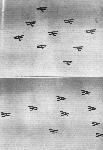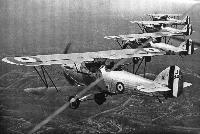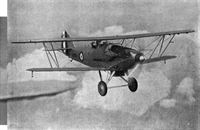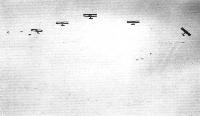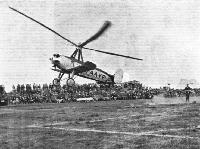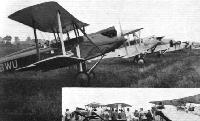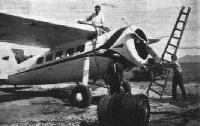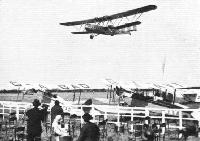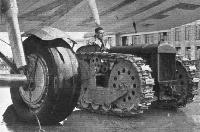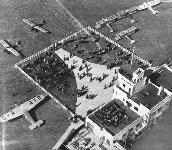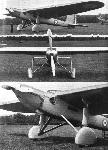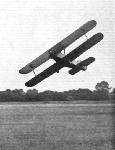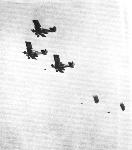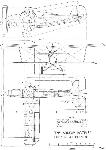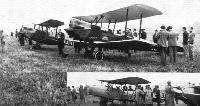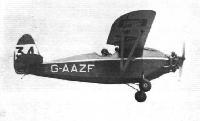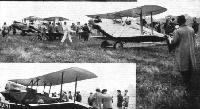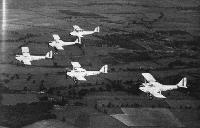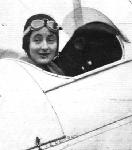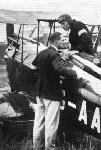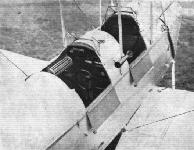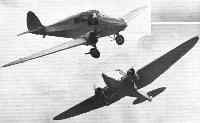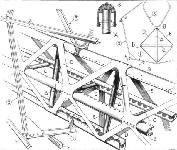Фотографии
-
No. 12 (BOMBER) SQUADRON IN NORMAL SQUADRON FORMATION.
Самолёты на фотографии: Hawker Hart - Великобритания - 1928
-
AT THE SIGN OF THE WHITE HART: No. 12 (BOMBER) SQUADRON ASSUMES MANY NEW SHAPES.
Самолёты на фотографии: Hawker Hart - Великобритания - 1928
-
"SOMEWHERE IN BLUELAND": No. 12 (Bomber) Squadron in readiness at Andover before setting off to raid Redland.
Самолёты на фотографии: Hawker Hart - Великобритания - 1928
-
Регистрационный номер: J9934 AT ANDOVER: In the foreground stands a "Hyderabad" of No. 503 (County of Lincoln) (Bomber) Squadron, which acted as "Friendly Bombers." In front of it is a reserve machine of No. 33 (Bomber) Squadron; and in the background are the "Harts" of No. 12 (Bomber) Squadron.
Самолёты на фотографии: Handley Page Hyderabad/H.P.24 / Hinaidi/H.P.33 / Clive/H.P.35 - Великобритания - 1923Hawker Hart - Великобритания - 1928
-
Регистрационный номер: J9942, J9943 AS THE WING MAN SEES THEM: A FORMATION OF HAWKER "HARTS," PHOTOGRAPHED FROM THE EXTREME LEFT-HAND MACHINE OF A VEE FORMATION.
Самолёты на фотографии: Hawker Hart - Великобритания - 1928
-
Регистрационный номер: K1955 A NEW TWO-SEATER FIGHTER: The Hawker "Hart" has now been produced as a two-seater fighter, fitted with Rolls-Royce "Kestrel" super-charged engine, and is taking part in the Air Exercises.
THE HAWKER "DEMON." Rolls-Royce "Kestrel" engine. A two seater aircraft possessing excellent fighting qualities and unequalled performance.
Hart K1955 photographed in July 1931, the month that it was delivered to 23 Sqn at RAF Kenley for two-seat fighter trials.Самолёты на фотографии: Hawker Hart - Великобритания - 1928
-
NO.12 B.S. NOT SO NORMAL: QUERY - LINES ABREAST OR LINES ASTERN?
Самолёты на фотографии: Hawker Hart - Великобритания - 1928
-
Регистрационный номер: K1952 AFTER THE FIGHT: Refilling the tanks of the fighter "Harts" of No. 23 (F.) Squadron after a 15 minutes combat with No. 33 (B.) Squadron.
Самолёты на фотографии: Hawker Hart - Великобритания - 1928
-
This model, constructed by H. W. Austin, T.M.A.C., was based on the Hawker "Hart" Day Bomber, and follows its design in general appearance. A dihedral angle was given to the top plane for stability. Details: Span, 46 in.; Length, 34 in.; Weight, 24 oz.; Wing loading, 6 1/2 oz./sq. ft.; Performance, 150 yards hand launched, 100 yards, R.O.G.
Самолёты на фотографии: Hawker Hart - Великобритания - 1928
-
Регистрационный номер: PK-AFC, H-NAFC THE JAVA-AUSTRALIA AIR MAIL: The 3-engined Fokker monoplane "Abel Tasman," piloted by Pattist, refuelling at Rambang on May 12 on the first Dutch Air Mail Service from Holland to Australia.
Самолёты на фотографии: Fokker F.VII / C-2 / F.XIV - Нидерланды - 1924
-
RIVAL AEROBATICS: The Gourdou-Leseurre (420 h.p. Gnome-Rhone "Jupiter"), used by Pierre Lemoigne, of France
Самолёты на фотографии: Gourdou-Leseurre GL-31 / LGL-32 - Франция - 1925
-
"LET ME GET AT THEM": A "Bulldog" of No. 23 (F.) Squadron off on receipt of a raid warning.
Самолёты на фотографии: Bristol Bulldog - Великобритания - 1927
-
THE "BULLDOGS" SHOW THEIR TEETH. A WING OF NOS. 3, 17, AND 54 (FIGHTER) SQUADRONS. THE LEADING SQUADRON IS CHANGING FORMATION.
Самолёты на фотографии: Bristol Bulldog - Великобритания - 1927
-
THE FLEET FIGHTERS BREAK FORMATION.
Самолёты на фотографии: Bristol Bulldog - Великобритания - 1927
-
A MIXED GRILL: A formation of seven different types over Wittering, viz., "Gamecock," "Atlas," "Moth," "Fairey III F," "Avro-Lynx," "Siskin," and "Bulldog."
Самолёты на фотографии: Armstrong Whitworth Atlas / Ajax - Великобритания - 1925Armstrong Whitworth Siskin - Великобритания - 1921Avro Avro 504N - Великобритания - 1920Bristol Bulldog - Великобритания - 1927De Havilland Gipsy Moth / Moth X - Великобритания - 1928Fairey Fairey IIIF - Великобритания - 1926Gloster Gamecock - Великобритания - 1925
-
Регистрационный номер: K1672 "STRAINING AT THE LEASH": The "Bulldogs" and fighter "Harts" of No. 23 (Fighter) Squadron waiting at Kenley for orders to go up and:attack raiders.
Самолёты на фотографии: Bristol Bulldog - Великобритания - 1927Hawker Demon - Великобритания - 1932
-
Самолёты на фотографии: Bristol Bulldog - Великобритания - 1927
-
Самолёты на фотографии: Bristol Bulldog - Великобритания - 1927
-
THE "BULLDOGS" SHOW THEIR TEETH. ONE SQUADRON IN A V.
Самолёты на фотографии: Bristol Bulldog - Великобритания - 1927
-
THEY'RE OFF! THE SIX PARACHUTES GENTLY BUT FIRMLY WITHDRAW THE SIX PARACHUTISTS FROM THE THREE VICKERS "VIMYS"
Самолёты на фотографии: Vickers Vimy / FB.27 - Великобритания - 1917
-
Members of the C.U.S.A. studying a map.
Самолёты на фотографии: Bristol F.2A/F.2B Fighter - Великобритания - 1916
-
"AND THEN THERE WERE FOUR": ONE OF THE HEAVY BOMBERS ("HYDERABADS" ) , WHICH ARE ABOUT TO BOMB THE ENEMY GUN POSITION, FALLS A VICTIM TO THE ATTACKING FIGHTER SQUADRON ("SISKINS").
Самолёты на фотографии: Armstrong Whitworth Siskin - Великобритания - 1921Handley Page Hyderabad/H.P.24 / Hinaidi/H.P.33 / Clive/H.P.35 - Великобритания - 1923
-
Регистрационный номер: G-ABEG The Westland "Wessex" in which the Prince of Wales flew back to London from Plymouth, piloted by Fl.-Lt. E. H. Fielden.
Самолёты на фотографии: Westland Wessex / Westland IV - Великобритания - 1929
-
A bow view which shows how small the seaplane is and the small target offered by a submarine when head-on. The Peto is here in position on the catapult rails and is all ready for launching. The rails being fairly high hold the aircraft clear of all obstructions and it is not therefore, necessary to dismantle any of the handrails and stanchions.
Самолёты на фотографии: Parnall Peto - Великобритания - 1925
-
Регистрационный номер: N255 [4] LETTING HER GO: Looking down on the Peto just as the catapult was fired.
Самолёты на фотографии: Parnall Peto - Великобритания - 1925
-
Регистрационный номер: N255 [4] UP INTO ACTION: The sequence of operations is shown here. First the submarine comes to the surface, and when the bow is clear of the water the hangar door is opened. Next the aircraft is run out and placed on the catapult, where the wings are unfolded, finally, after the engine has been run up, the catapult is fired and the aircraft flies off on a reconnaissance flight.
Самолёты на фотографии: Parnall Peto - Великобритания - 1925
-
Регистрационный номер: N255 [4] DOWN TO SAFETY: After having carried out the reconnaissance flight the little seaplane alights near the submarine where the derrick is already trained over the ship's side. The aircraft then taxis up and is hooked on, lifted up and swung on board and placed on the catapult rails. After the wings are folded it is pushed back into the hangar, which is closed, and once more the submarine dives out of sight.
Самолёты на фотографии: Parnall Peto - Великобритания - 1925
-
Регистрационный номер: N255 [4] The Parnall Peto flying past H.M. Submarine M.2.
Самолёты на фотографии: Parnall Peto - Великобритания - 1925
-
THE HANGAR CREW: Above (left to right) are Able-Seaman E. A. Evans, Stoker J. Drutnmond, Chief Engine Room Artificer C. Hardy, and Able-Seaman R. Smith. In the front row are Warrant Engineer E. P. Birkett, Leading-Aircraftman L. Gregory, Lieutenant T. H. Villiers, R.N. (pilot), Lieutenant C. R. Townsend, R.N. (observer), Leading - Aircraftman F. J. Harman and Able-Seaman G. England.
Самолёты на фотографии: Parnall Peto - Великобритания - 1925
-
Регистрационный номер: G-AAYP A fine photograph of the Autogiro just after Mr. Alliot had removed the tape from its tail skid while it was flying across the aerodrome. The tennis court used for landing can be seen in the foreground.
Самолёты на фотографии: Cierva/Avro C.19 - Великобритания - 1929
-
Регистрационный номер: G-AACN, K1947 EXPERIMENTAL RESEARCH: THE HANDLEY PAGE "GUGNUNC," THE CIERVA "AUTOGIRO," AND THE HLLL-WESTLAND "PTERODACTYL" IN FLIGHT FORMATION. RIGHT-HAND CIRCUITS WERE MADE SO THAT THE GUGNUNC COULD "MARK TIME" WHILE THE "PTERODACTYL" WENT FULL SPEED.
Самолёты на фотографии: Cierva/Avro C.19 - Великобритания - 1929Handley Page Gugnunc / H.P.39 - Великобритания - 1929Westland-Hill Pterodactyl IV - Великобритания - 1931
-
Регистрационный номер: G-EBWU SCENES AT THE START: 1 - Nos. 23 (Avian IV Cirrus III), 22 (Avian IV Cirrus III), 21 (Widgeon III Genet II), 28 (Martlet Genet II), 27 (Widgeon III Hermes II) lined up for the start.
Самолёты на фотографии: Avro Avian / Type 594/616 - Великобритания - 1926Southern Martlet - Великобритания - 1929Westland Widgeon - Великобритания - 1924
-
Регистрационный номер: G-EBRQ "FORTY MINUTES": Some of the Competitors - Nos. 21 (Widgeon III Genet II), 20 (D.H.Moth Gipsy I), 18 (Widgeon III Gipsy I) and 14 (Spartan Hermes II) - refuelling at Heston on the first lap.
Самолёты на фотографии: De Havilland Gipsy Moth / Moth X - Великобритания - 1928Simmonds Spartan - Великобритания - 1928Westland Widgeon - Великобритания - 1924
-
TOURING IN A "VEGA": Miss Margery Durant has been carrying out a sight-seeing tour round the Mediterranean in her Lockheed "Vega." Our illustration shows the machine collecting "Shells" at Tunis, where a halt was made last May.
Самолёты на фотографии: Lockheed Vega - США - 1927
-
IGNORING THE WEATHER: Mr. Staniland's exhibition on the Fairey "Firefly" in the weather which Heston suffered on Saturday was one of the most imposing ever seen. He is here seen just starting a climbing roll.
Самолёты на фотографии: Fairey Firefly - Великобритания - 1925
-
THE first batch of "Firefly" interceptors (Rolls-Royce "Kestrel" engines) for the Belgian Air Force has now been completed at the Fairey works at Hayes, and are going through their acceptance tests in the presence of Belgian representatives. The photographs show a line of "Fireflies" and two views of a machine in flight, piloted by Mr. Staniland.
Самолёты на фотографии: Fairey Firefly - Великобритания - 1925
-
THE "FURIES": THESE MACHINES OF NO. 43 (FIGHTER) SQUADRON COMING OUT OF A LOOP IN LINE ASTERN.
Самолёты на фотографии: Hawker Fury - Великобритания - 1931
-
THE AUXILIARY AIR FORCE: A BOMBER WING COMPOSED OF THE CITY OF LONDON, COUNTY OF LONDON AND COUNTY OF MIDDLESEX SQUADRONS. ALL FLYING "WAPITIS."
Самолёты на фотографии: Westland Wapiti - Великобритания - 1927
-
FOR USE IN COLD CLIMATES: A new type of cowling has been produced by the Avro company for their Trainer (621) and Advanced Trainer (626) machines. The openings in the cowling can be adjusted from the cockpit by a Bowden cable and plunger arrangement.
Самолёты на фотографии: Avro Tutor/Sea Tutor/Prefect / Type 621/646/626 - Великобритания - 1929
-
A view in the cockpit of the Avro Tutor, over which the hood is pulled for blind flying instruction. The Reid and Sigrist Turn Indicator occupies the centre position.
Самолёты на фотографии: Avro Tutor/Sea Tutor/Prefect / Type 621/646/626 - Великобритания - 1929
-
Регистрационный номер: G-AAGX [2] COMPLETE WITH CERTIFICATE OF AIRWORTHINESS: The Handley Page "Hannibal" (four Jupiters) leaving Hanworth for Croydon.
"Owing to his great size it is difficult to appreciate Hannibal's proportions, except at a considerable distance; as seen from the ground, or preferably from another plane, he appears quite graceful in flight."Самолёты на фотографии: Handley Page H.P.42 / H.P.45 - Великобритания - 1930
-
Регистрационный номер: G-AAUE [2] "Hadrian" has a look at the meeting.
Самолёты на фотографии: Handley Page H.P.42 / H.P.45 - Великобритания - 1930
-
Регистрационный номер: G-AAUE [2] JACK-THE-GIANT HAULER: This is the Fordson caterpillar tractor, now used at Croydon for hauling the giant airliners about.
Самолёты на фотографии: Handley Page H.P.42 / H.P.45 - Великобритания - 1930
-
Регистрационный номер: G-AAGX [2] The Forward Cabin of the "Hannibal" (Eastern Type), looking aft.
Самолёты на фотографии: Handley Page H.P.42 / H.P.45 - Великобритания - 1930
-
Регистрационный номер: G-ABLS OFF ON THE SECOND ROUND: Some of the competitors waiting for the signal to start from Heston on the second round of the King's Cup.
Самолёты на фотографии: De Havilland Puss Moth / D.H.80 - Великобритания - 1929
-
DE HAVILLAND REPRESENTATIVES: Four machines are shown by this firm, two in the Exhibition and two flying at El Palomar. In both cases the machines are a "Gipsy-Moth" and a "Puss-Moth."
Самолёты на фотографии: De Havilland Puss Moth / D.H.80 - Великобритания - 1929
-
Регистрационный номер: ZS-ACA, ZS-ACC, ZS-ACF DE HAVILLANDS IN SOUTH AFRICA: Moths and Puss Moths lined up at Baragwanath Aerodrome prior to flying to Witbank to take part in the Witbank Flying Club's Pageant. Standing by the nearest Puss Moth is Mr. J. Davison, Secretary of The De Havilland Aircraft Co., of S.A. (Pty.), Ltd.
Самолёты на фотографии: De Havilland Gipsy Moth / Moth X - Великобритания - 1928De Havilland Puss Moth / D.H.80 - Великобритания - 1929
-
Регистрационный номер: G-AAVY, G-AAYR, G-ABAD, G-ABDH, G-ABFY, G-ABHR, G-ABNN An Aerial view taken just as the Prince of Wales stepped out of his Puss Moth. His second machine brought one of his equerries. The Band of H.M. Grenadier Guards can be seen on the roof of the Club House.
G-AAYR - Avro Six; G-ABNN, G-ABFY, G-ABDH - D.H. Puss Moth; G-ABAD, G-AAVY - D.H. Gipsy Moth; G-ABHR - Spartan ArrowСамолёты на фотографии: Avro Five / Type 619 / Six / Type 624 - Великобритания - 1929De Havilland Gipsy Moth / Moth X - Великобритания - 1928De Havilland Puss Moth / D.H.80 - Великобритания - 1929Spartan Arrow - Великобритания - 1930
-
Mr. and Mrs. Humble who landed at Heston on Sunday, June 28, after having flown from Capetown in their Puss Moth (Gipsy III) in 18 flying days at an average speed of 105 m.p.h. Mr. Humble is a director of a British firm of electrical switchgear makers and has only been flying a year. He rises his aircraft for business trips and came home via Johannesburg, Nairobi and Cairo.
Самолёты на фотографии: De Havilland Puss Moth / D.H.80 - Великобритания - 1929
-
One of types of monoplane in the Circuit of Italy race. Capt. H. Broad's D.H. "Puss Moth"
Самолёты на фотографии: De Havilland Puss Moth / D.H.80 - Великобритания - 1929
-
Регистрационный номер: G-ABIY SCENES AT THE START: 5 - The Puss Moths lined up, Mr. Jackaman's is the one nearest the camera and looks fast with the spats on its wheels.
Самолёты на фотографии: De Havilland Puss Moth / D.H.80 - Великобритания - 1929
-
Регистрационный номер: K1991 THE FAIREY LONG-RANGE MONOPLANE: The new machine is now completed and has been flying. Like the first machine, it is fitted with a Napier "Lion" engine. Refinements have been added to this second machine, such as the spats over the undercarriage wheels. The centre photograph indicates how "clean" the new machine is.
Самолёты на фотографии: Fairey Long-Range Monoplane - Великобритания - 1928
-
Регистрационный номер: F-ADEK Самолёты на фотографии: Wibault Wibault 280 - Франция - 1930
-
Регистрационный номер: D-2000, D-AZUR WELL AWAY: A good picture of the giant Junkers "G.38" commercial monoplane taking off during its recent tour of Europe.
Самолёты на фотографии: Junkers G 38 - Германия - 1929
-
Регистрационный номер: D-822 OUR GERMAN VISITOR: Herr Udet is here seen "skating" his "Flamingo" sideways across the Aerodrome.
Самолёты на фотографии: Udet U-12 Flamingo - Германия - 1925
-
Регистрационный номер: S1593 LAUNCH OF A NEW BLACKBURN "IRIS": Yet another flying boat of the "Iris" type was launched at the Blackburn works at Brough, Yorks, recently. Like previous machines of this type it is fitted with Rolls-Royce "Condor" engines. Modifications have, however, been made to the lines ot the hull, notably in the bows. The lower picture gives a good idea of the biplane tail and gunner's position.
Самолёты на фотографии: Blackburn Iris / R.B.1 - Великобритания - 1926
-
"THAT'S THE STUFF TO GIVE THE TROOPS." NO. 13 (A.C.) SQUADRON DROPS SUPPLIES.
Самолёты на фотографии: Armstrong Whitworth Atlas / Ajax - Великобритания - 1925
-
"WE WANT MORE BEER." THE "ATLAS" MACHINES WITH HOOKS DOWN TO PICK UP MESSAGES
Самолёты на фотографии: Armstrong Whitworth Atlas / Ajax - Великобритания - 1925
-
Регистрационный номер: G-ABIX [3] FOR INTERMEDIATE TRAINING: The "Active," designed and built by Arrow Aircraft (Leeds) Ltd., is a single seater of all-metal construction, intended for training single-seater fighter pilots at low cost. The engine is a Cirrus-Hermes IIB inverted. The "Active" is very "clean," and is reported to have an excellent performance.
Самолёты на фотографии: Arrow Active - Великобритания - 1931
-
Регистрационный номер: G-ABIX [3] ARROW "ACTIVE": This front view shows very well the "clean" design. The engine is a Cirrus-Hermes inverted type II B.
The Active I, G-ABIX, in its original form in 1931 with a 115 h.p. Cirrus Hermes IIB engine. Note the clean lines, low frontal area and sesquiplane layout.Самолёты на фотографии: Arrow Active - Великобритания - 1931
-
Регистрационный номер: G-ABIX [3] THE ARROW "ACTIVE": Rear view. Bristol-Frise ailerons are fitted to the upper wings only.
Самолёты на фотографии: Arrow Active - Великобритания - 1931
-
The Arrow "Active" Cirrus-Hermes II B Engine
Самолёты на фотографии: Arrow Active - Великобритания - 1931
-
Регистрационный номер: G-AAXH Самолёты на фотографии: Avro Avian / Type 594/616 - Великобритания - 1926
-
AN AVRO "AVIAN" FOR SURVEY WORK IN TANGANYIKA: Note the air filter fitted to the air intake to prevent dust and from entering the air intake. The Vickers-Potts oil cooler will be noticed.
Самолёты на фотографии: Avro Avian / Type 594/616 - Великобритания - 1926
-
SCENES AT THE START: 3 - Miss Brown's Avian "Jerry" is nearest the camera (this is of course her new machine and not the one she won on last year), with Lord Douglas Hamilton's Moth just behind.
Самолёты на фотографии: Avro Avian / Type 594/616 - Великобритания - 1926De Havilland Gipsy Moth / Moth X - Великобритания - 1928
-
Регистрационный номер: G-ABLU FOR IMPERIAL AIRWAYS: The second of the Avro 10 three-engined (Armstrong-Siddeley commercial monoplanes which have been supplied to Imperial Airways Ltd.
Самолёты на фотографии: Avro Ten / Type 618 - Великобритания - 1928
-
A VISITOR TO ALL CONTROLS : The three-engined Ford (Wasps) is here seen at Whitchurch (Bristol).
Самолёты на фотографии: Ford Tri-Motor / 4-AT / 5-AT - США - 1926
-
H.R.H. The Prince of Wales showed great interest in the 3-engined Ford and is here seen emerging after having looked over it, together with Capt. Baker the Chief Instructor at Heston.
Самолёты на фотографии: Ford Tri-Motor / 4-AT / 5-AT - США - 1926
-
FOR THE KING'S CUP: The new Bluebird with a Gipsy III engine, which Mrs. Victor Bruce will fly in the King's Cup Race.
Самолёты на фотографии: Blackburn Bluebird / L.1 - Великобритания - 1924
-
THE WINNER: F./O. Edwards, in the Blackburn "Bluebird" (Hermes) immediately after arriving first back at Heston on the second lap.
Самолёты на фотографии: Blackburn Bluebird / L.1 - Великобритания - 1924
-
MORE SMOKED AEROBATICS: THE FORMATION OF A HUGE SPIRAL
Самолёты на фотографии: Gloster Grebe - Великобритания - 1923
-
AEROBATICS IN SMOKE: THE THREE "GREBES" FORMING "PRINCE OF WALES' FEATHERS." SIX PICTURES SHOW, FROM TOP TO BOTTOM, PROGRESSIVE STAGES IN THE MANOEUVRE
Самолёты на фотографии: Gloster Grebe - Великобритания - 1923
-
MORE SMOKED AEROBATICS: A TRIPLE LOOP
Самолёты на фотографии: Gloster Grebe - Великобритания - 1923
-
Самолёты на фотографии: Gloster Grebe - Великобритания - 1923
-
AEROBATICS IN SMOKE: THE THREE "GREBES" FORMING "PRINCE OF WALES' FEATHERS." THE EFFECT OBTAINED BY USING COLOURED SMOKE (ORANGE AND WHITE) IS VERY MARKED.
Самолёты на фотографии: Gloster Grebe - Великобритания - 1923
-
MORE SMOKED AEROBATICS: THE SIX VIEWS AGAIN SHOW PROGRESSIVE STAGES: THIS TIME IN THE FORMATION OF A WREATH OF INTERWOVEN ORANGE AND WHITE TRAILS.
Самолёты на фотографии: Gloster Grebe - Великобритания - 1923
-
CATAPULTED: A "VIRGINIA" NIGHT-BOMBER IS SHOT INTO THE AIR BY A 4,000 H.P. ENGINE AFTER A 100 FEET RUN.
Самолёты на фотографии: Vickers Virginia - Великобритания - 1922
-
THE "VIRGINIAS" DROP SMOKE BOMBS.
Самолёты на фотографии: Vickers Virginia - Великобритания - 1922
-
NO. 7 (BOMBER) SQUADRON OUT FOR BLOOD.
Самолёты на фотографии: Vickers Virginia - Великобритания - 1922
-
Регистрационный номер: I-RATO Sig. ing. Ambrogio Colombo, who was the first to arrive at Palermo on a Breda 33 monoplane. He was the winner of the Circuit of Italy Air Race. He was flying one of the New Breda 33 low-wing monoplanes, fitted with a Gipsy III engine.
Самолёты на фотографии: Breda Ba.33 / Ba.39 / Ba.42 - Италия - 1931
-
Регистрационный номер: I-LARE Two views of the Breda 33 Monoplane ("Gipsy III"), showing the sliding windows to the cockpit open and closed.
Самолёты на фотографии: Breda Ba.33 / Ba.39 / Ba.42 - Италия - 1931
-
One of types of monoplane in the Circuit of Italy race. The new Breda 33 ("Gipsy III") low wing monoplane.
Самолёты на фотографии: Breda Ba.33 / Ba.39 / Ba.42 - Италия - 1931
-
Регистрационный номер: G-AAZF [3] Самолёты на фотографии: Comper Swift / CLA.7 - Великобритания - 1930
-
Регистрационный номер: G-AAZF [3] SORELY TRIED AND NOT FOUND WANTING: The diminutive Comper "Swift" flown by Sqdn.-Ldr. Robb did not succeed in getting a place, but it did get in sixth, which was a very creditable performance indeed in view of the fact that the Pobjoy R.I engine is an entirely new type. The engine gave no trouble whatever, a fact which promises well for the future of the Pobjoy R.I. The "Swift," incidentally, was favourite on the "Tote."
Самолёты на фотографии: Comper Swift / CLA.7 - Великобритания - 1930
-
Регистрационный номер: G-AAZF [3] SCENES AT THE START: 4 - The Comper Swift was naturally a centre of interest, being second only to Mr. Webster's Rambler.
Самолёты на фотографии: Comper Swift / CLA.7 - Великобритания - 1930Reid Rambler - Канада - 1928
-
A "FLYCATCHER" BOMBS THE CAMP.
Самолёты на фотографии: Fairey Flycatcher - Великобритания - 1922
-
Регистрационный номер: G-AAVD The Martlet ("Genet"). This is the only aircraft built private owners who want to stunt. It originates from Aircraft factory at Shoreham.
Самолёты на фотографии: Southern Martlet - Великобритания - 1929
-
SCENES AT THE START: 2 - Mr. Bramson and F./O. Leech running up the engines of their Martlets.
Самолёты на фотографии: Southern Martlet - Великобритания - 1929
-
BIG GAME HUNTING FROM THE AIR. HERE WE SEE THE HUNTER, IN A FAIREY IIIF, TAKING A SHOT AT THE SOFT ROE FLOPPITY - ONE OF SEVERAL FIERCE AND WEIRD MONSTERS WHICH "ESCAPED" FROM LOCAL ZOO
Самолёты на фотографии: Fairey Fairey IIIF - Великобритания - 1926
-
A FRENCH AMPHIBIAN: The Schreck 310 (120 h.p. Lorraine) two-seater amphibian.
Самолёты на фотографии: FBA Type 310 - Франция - 1930
-
Captain S. D. Scott, Saunders-Roe's chief test pilot, who piloted the "Cutty Sark" on her cruise.
Самолёты на фотографии: Saunders-Roe Cutty Sark / A.17 - Великобритания - 1929
-
LOCAL INTEREST: The "Cutty Sark," with a few admirers, at Sarajevo.
Самолёты на фотографии: Saunders-Roe Cutty Sark / A.17 - Великобритания - 1929
-
The Spartan "Arrow" Seaplane (Hermes II) which has recently been supplied to the Hon. A. F. Guiness, who has disposed of his Moth (Hermes II) which was fitted with the Short Amphibian undercarriage.
Самолёты на фотографии: Spartan Arrow - Великобритания - 1930
-
AN AERIAL LORRY. Three-quarter view of the Ju. 52, the new Junkers freighter. The tail wheel and the mounting of the elevator above the tail plane should be noticed; this would appear to have a sort of reverse slot-like effect.
Самолёты на фотографии: Junkers Ju.52/1m - Германия - 1930
-
Регистрационный номер: F-AISK A WINNER: The Morane "Parasol" (230 h.p. Salmson) used by the winning pair in the Marquise de Sevigne Cup - Efficiency Competition.
Самолёты на фотографии: Morane-Saulnier MS.137 / MS.138 / MS.147 - 149 / MS.191 - Франция - 1927
-
"PER MARE, PER TERRAM." THE "SOUTHAMPTONS" OF NO. 204 (FLYING BOAT) SQUADRON ARE NOT IN THE LEAST AFRAID TO FLY ACROSS LAND.
Самолёты на фотографии: Supermarine Southampton / Solent - Великобритания - 1925
-
Регистрационный номер: G-AAJY [2] SIR ALAN COBHAM'S AFRICAN FLIGHT: Sir Alan, with other members of the crew, standing on a float of the Short "Valetta."
Самолёты на фотографии: Short Valetta / S.11 - Великобритания - 1930
-
Регистрационный номер: G-AAJY [2] THE SHORT "VALETTA": The large mono-seaplane, fitted with three 490 h.p. Bristol "Jupiter" engines, in which Sir Alan Cobham is making a survey flight to Central Africa.
Самолёты на фотографии: Short Valetta / S.11 - Великобритания - 1930
-
Регистрационный номер: G-ABLI THE SARO PERCIVAL MONOPLANE: The Saro Percival Monoplane is the first 3-engined long-range mail plane to be built in this country, and from the preliminary tests it would appear that it will fulfil this duty in a remarkably efficient manner. The engines are three Gipsy III's and, as can be seen from the photograph, are very neatly cowled in. The landing run is very short indeed, while the landing speed, although figures may not yet be quoted, is also very low. This fact, together with the immunity from forced landings which the three-engine arrangement will give, should make the Saro Percival an ideal night mail carrier; a type which will be found invaluable in many parts of the world.
Самолёты на фотографии: Spartan Cruiser - Великобритания - 1932
-
Oxford University Air Squadron is at present undergoing its annual training at Eastchurch. This photograph shows a formation of "Avros" (Lynx) over the estuary of the Thames.
Самолёты на фотографии: Avro Avro 504N - Великобритания - 1920
-
The Oldest and the Youngest.
Самолёты на фотографии: Avro Avro 504N - Великобритания - 1920
-
A Cambridge "Rag."
Самолёты на фотографии: Avro Avro 504N - Великобритания - 1920
-
Регистрационный номер: K1244 [2] TAKING OFF SOLO BY INSTRUMENTS ONLY: An instructor (Mr. W.E.P.Johnson) takes off solo with the hood up. He put the machine into a spin and flattened out before lowering his hood. We believe that this is the first photograph ever published of this extraordinary feat.
Самолёты на фотографии: Avro Avro 504N - Великобритания - 1920
-
Регистрационный номер: K1244 [2] INSTRUMENT FLYING: These two pictures of the same Avro-Lynx illustrate instruction in flying solely by instruments. In the first the head of the pupil can be seen, in the second it is hidden by the hood. The instructor is in the front cockpit.
Самолёты на фотографии: Avro Avro 504N - Великобритания - 1920
-
THE SPARTAN: In the race are entered two with Hermes II and two with Cirrus III engines.
Самолёты на фотографии: Simmonds Spartan - Великобритания - 1928
-
Регистрационный номер: G-AAHA FIRST ARRIVAL AT HOOTON: Flt.-Lt. Gibbons has his Spartan (Hermes II) refuelled. He was away again before one-half of his competitors arrived from Sherburn.
Самолёты на фотографии: Simmonds Spartan - Великобритания - 1928
-
FIRST IN FIRST ROUND: Fl.-Lt. Gibbons (Spartan), the first back at Heston on the first round of the King's Cup.
Самолёты на фотографии: Simmonds Spartan - Великобритания - 1928
-
Регистрационный номер: CF-ABZ Mr. John C. Webster, a Director of the Montreal Light Aeroplane Club, with his Curtiss-Reid Rambler (Gipsy III), which he is flying in the King's Cup Race. Mr. Webster brought his aircraft over unpacked, that is, simply folded and secured on board. At Southampton it was towed to Hamble where its wings were spread and it was flown to Heston. There it will be cared for by the firm of Brian Lewis and C. D. Barnard Ltd., while in the country.
Самолёты на фотографии: Reid Rambler - Канада - 1928
-
Curtiss-Reid "Rambler III"
Самолёты на фотографии: Reid Rambler - Канада - 1928
-
A NEW BREDA DEVELOPMENT: In our issue for June 12 last we published illustrations of a Breda "15" light plane fitted with an inverted engine, which provided greatly improved vision. Above we show another development, a Breda "15" seaplane fitted with an 105 h.p. Isotta-Fraschini Asso 80 Ri. 6-cyI. engine. This is an upright in line engine, but fitted with reduction gear which enables the engine to be placed low down in the fuselage, thus retaining the features of the upright type with the advantages of the inverted engine. The main characteristics of this machine - which has wooden wings and welded steel tube fuselage - are: span, 38 ft. 9 in.; wing area, 236-7 sq. ft.; weight empty, 1,279 lbs.; useful load, 617-4 lbs.; total weight, 1,896-4 lbs.; speed range, 43 - 105 m.p.h.; climb, 8,200 ft. in 21 min.; duration (cruising speed), 5 hrs. The Breda Company are delivering 100 of these seaplanes to civilian aero clubs in different parts of Italy.
Самолёты на фотографии: Breda Ba.15 - Италия - 1928
-
Регистрационный номер: G-ABKM [2] EASE OF INGRESS AND EGRESS: Larger doors have been fitted to the Moth Trainer, so that in emergency both occupants can get clear with their parachutes.
Самолёты на фотографии: De Havilland Gipsy Moth / Moth X - Великобритания - 1928
-
Регистрационный номер: G-ABKM [2] Самолёты на фотографии: De Havilland Gipsy Moth / Moth X - Великобритания - 1928
-
The five "Moths" of the Display Flight in abnormal flying position.
Самолёты на фотографии: De Havilland Gipsy Moth / Moth X - Великобритания - 1928
-
NO WIRES IN THE WAY: This illustration shows how the shifting of the lift wire attachments to the front has made it possible for the occupant to escape by parachute in case of emergency.
Самолёты на фотографии: De Havilland Gipsy Moth / Moth X - Великобритания - 1928
-
ANOTHER WINNER: The D.H. "Gipsy Moth" of Louis Weber, Director of Geneva Airport, who won the George Dreyfus Speed Race.
Самолёты на фотографии: De Havilland Gipsy Moth / Moth X - Великобритания - 1928
-
Самолёты на фотографии: De Havilland Gipsy Moth / Moth X - Великобритания - 1928
-
THE C.F.S. DISPLAY FLIGHT: The leader (with streamer) is in his normal flying position; the rest are showing that they can fly upside up.
Самолёты на фотографии: De Havilland Gipsy Moth / Moth X - Великобритания - 1928
-
"HERE WE GO ROUND...": The five "Moths" form a circle, still in normal flying position.
Самолёты на фотографии: De Havilland Gipsy Moth / Moth X - Великобритания - 1928
-
THIS SIDE UP WITH CARE. "MOTHS" OF THE CENTRAL FLYING SCHOOL.
Самолёты на фотографии: De Havilland Gipsy Moth / Moth X - Великобритания - 1928
-
LINE ASTERN: Five "Moths" flown by C.F.S. instructors upside down. They seem to regard this position as quite normal.
Самолёты на фотографии: De Havilland Gipsy Moth / Moth X - Великобритания - 1928
-
WELL TRIED! Miss F. J. Crossley, who gallantly piloted her Moth over the full 982-5 mile course of King's Cup Race, and was the only women competitor to finish.
Самолёты на фотографии: De Havilland Gipsy Moth / Moth X - Великобритания - 1928
-
AT MOUSEHOLD: Lord Malcolm Douglas-Hamilton getting ready to leave.
Самолёты на фотографии: De Havilland Gipsy Moth / Moth X - Великобритания - 1928
-
The McGill University Light Aeroplane Club have recently taken delivery of this 1931 Moth (Gipsy II). The club is affiliated to the Montreal Light Aeroplane Club whose instructor, Capt. H. Spooner, is on the left with his ground engineer, Mr. F. Hopkins, on the right. This Moth is the first aeroplane to be delivered to a University Club in Canada.
Самолёты на фотографии: De Havilland Gipsy Moth / Moth X - Великобритания - 1928
-
MANUALLY OPERATED. - The cockpit of a D.H. "Moth," which has been specially built for Capt. Chevalier Willy Coppens, Order of St. Leopold, D.S.O., M.C., Legion d'Honneur, Belgian Air Attache in London and Paris. It will be seen from the accompanying illustration that the controls have been arranged to obviate the use of a rudder bar, since Capt. Willy Coppens has had the misfortune to lose a leg. The wheel is rotated to work the rudder, and the whole column worked sideways and fore and aft in the usual manner for ailerons and elevator. The "bird-cage" on the left is a special map-holder.
Самолёты на фотографии: De Havilland Gipsy Moth / Moth X - Великобритания - 1928
-
Регистрационный номер: G-ABKR THE MOTH TRAINER: In this three-quarter rear view may be seen the camera gun mounted on the port side of the fuselage, and the sight placed above the deck fairing.
Самолёты на фотографии: De Havilland Gipsy Moth / Moth X - Великобритания - 1928
-
THE DISPLAY FLIGHT ALL FLYING NORMALLY: Tyrannous authority forbids them to stay like this for more than five minutes.
Самолёты на фотографии: De Havilland Gipsy Moth / Moth X - Великобритания - 1928
-
FOR OFFENSIVE DUTY: Four 20 lb. bombs suspended below the fuselage. This illustration also shows the new exhaust pipe arrangement of the Moth Trainer.
Самолёты на фотографии: De Havilland Gipsy Moth / Moth X - Великобритания - 1928
-
The Austria amid the hay at Hanworth.
Самолёты на фотографии: Kupper Austria - Австрия - 1930
-
Mr. Lowe-Wylde on his B.A.C. getting ready to go up and find the clouds.
Самолёты на фотографии: Lowe-Wylde Columbus / BAC.II - BAC.IX - Великобритания - 1930
-
Mr. Mole on the Barbara Cartland getting ready to go up and find the clouds.
Самолёты на фотографии: Lowe-Wylde Columbus / BAC.II - BAC.IX - Великобритания - 1930
-
The clean lines of the Ishikawajima R3 make it look attractive and presage a good performance.
Самолёты на фотографии: Ishikawajima R-3 - Япония - 1930
-
Регистрационный номер: G-AARP [4] Самолёты на фотографии: Gloster, Monospar ST-3 - Великобритания - 1931
-
Регистрационный номер: G-AARP [4] NEW LINES: The general conception of the machine is unorthodox, apart from the construction, and good view from the cabin has been one of the considerations. The registration letters have photographed somewhat indistinctly. They are G-AARP.
Самолёты на фотографии: Gloster, Monospar ST-3 - Великобритания - 1931
-
Регистрационный номер: G-AARP [4] THE MONO-SPAR COMPANY'S EXPERIMENTAL MACHINE: These two views of the machine in flight show the excellent visibility from the cabin, and the pronounced taper of the wing. The engines are 50 h.p. Salmsons.
Самолёты на фотографии: Gloster, Monospar ST-3 - Великобритания - 1931
-
Регистрационный номер: G-AARP [4] IN SKELETON: The Mono-Spar Company's Experimental Machine before it was covered. The shallow depth girder which forms the main fuselage member is clearly seen.
Самолёты на фотографии: Gloster, Monospar ST-3 - Великобритания - 1931
-
THE FUSELAGE BOOM: Details of the construction. The corner strips and surrounding bracing are of Duralumin. The depth of the boom is approximately one foot, and it is placed in the bottom of the fuselage, the outer form of which is produced by hoops and stringers.
Самолёты на фотографии: Gloster, Monospar ST-3 - Великобритания - 1931
-
DETAILS OF THE WING CONSTRUCTION OF THE MONO-SPAR COMPANY'S EXPERIMENTAL MACHINE: The key diagram shows the location of the details illustrated in sketches A to H.
Самолёты на фотографии: Gloster, Monospar ST-3 - Великобритания - 1931
-
The Shackleton glider which has been found excellent for training and also for more advanced work in Australia. It is obvious that cheapness in production has been borne in mind in the design, which should make it very suitable for clubs.
Самолёты на фотографии: Larkin (Lasco) Lark - Австралия - 1931
-
Регистрационный номер: D-1655 RIVAL AEROBATICS: The Raab R.K. (240 h.p. Walter), flown by Dr. Hans Gullman, of Germany
Самолёты на фотографии: Raab-Katzenstein RK.26 Tigerschwalbe - Германия - 1929
-
An all-Australian light aircraft which has been designed, constructed, and flown by Mr. Staig, an amateur pilot of the Victoria Aero Club, at Essendon. The engine, which is not unlike Cirrus Mark I, has been designated "Cirrus Staig" - Mr. Staig having himself made pistons, cylinders, tappets and tappet rods. The 31-gallon tank capacity will give it a flying range of approximately 400 miles.
Самолёты на фотографии: Staig monoplane - Австралия - 1931
-
Herr Kronfeld in the Wien just before making his flight over Hanworth.
Самолёты на фотографии: Lippisch / RRG Wien - Германия - 1929
Статьи
- Flight

